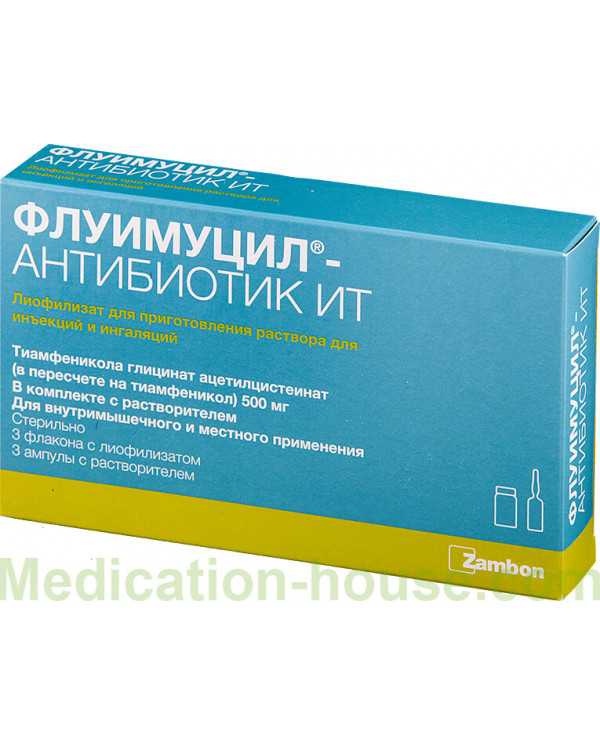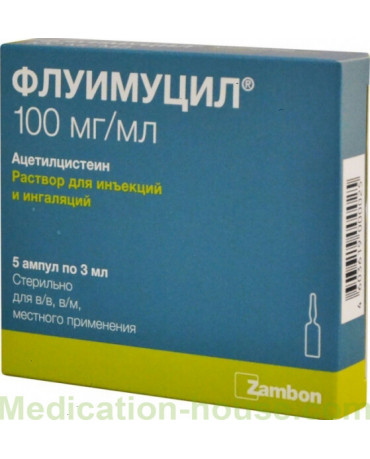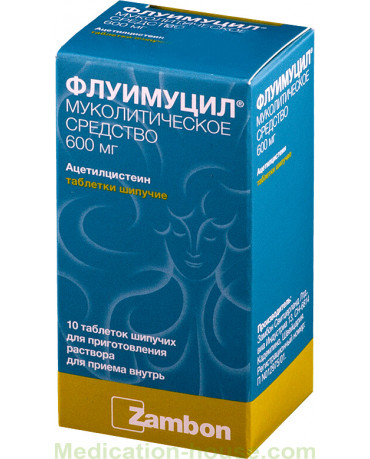Fluimucil-antibiotic IT instruction
You can buy Fluimucil-antibiotic IT here
Fluimucil-antibiotic IT is a combined antibacterial and mucolytic drug.
Release form and composition
lyophilisate for the preparation of a solution for injection and inhalation: a plate mass of pale yellow or white with a slight sulfuric odor (in a bottle of colorless glass complete with a solvent in an ampoule of 4 ml, in a plastic tray 3 sets, in a cardboard bundle 1 tray);
lyophilisate for solution for injection (in a glass bottle complete with a solvent in an ampoule of 4 ml, in a blister pack 3 sets, in a cardboard bundle 1 pack; in an ampoule, in a blister pack 3 ampoules, in a cardboard bundle 1 pack).
Solvent (4 ml) - water for injection: a colorless, clear, odorless and tasteless liquid.
In 1 bottle with lyophilisate for the preparation of a solution for injection / injection and inhalation contains:
active substance: thiamphenicol glycinate acetylcysteinate - 810 mg (which is equivalent to 500 mg thiamphenicol);
additional component: disodium edetate - 2.5 mg.
Pharmacodynamics of Fluimucil-antibiotic IT
Thiamphenicol glycinate acetylcysteinate is a complex compound that includes the antibiotic thiamphenicol and mucolytic acetylcysteine. After absorption, this compound splits into its constituent substances - thiamphenicol and acetylcysteine.
Thiamphenicol is a member of the group of chloramphenicol derivatives; its mechanism of action is associated with inhibition of bacterial cell protein production. The substance relates to antibacterial drugs with a wide spectrum of action. In vitro thiamphenicol demonstrates efficacy against bacteria that most often cause respiratory tract infections, both gram-positive (Corynebacterium diphtheriae, Streptococcus pneumoniae, Streptococcus pyogenes, Staphylococcus spp., Clostridium spp., Listeria spp.), And gram-negative. Haemophilus influenzae, Escherichia coli, Salmonella spp., Bordetella pertussis, Shigella spp., Brucella spp., Yersinia pestis, Bacteroides spp.).
Acetylcysteine as a result of the breakdown of mucoproteins disulfide bonds produced by it effectively and quickly dilutes sputum and pus, reduces their viscosity and facilitates discharge. Acetylcysteine promotes the penetration of thiamphenicol into the lung tissue and interferes with the adhesion of bacteria to the surface of the epithelium of the respiratory tract mucosa.
Pharmacokinetics
Thiamphenicol
Thiamphenicol is characterized by a rapid distribution in the body and accumulation in therapeutic concentrations in the tissues of the respiratory tract. After intramuscular (IM) administration, the maximum concentration (Cmax) is observed after 1 hour.
The binding of the substance to plasma proteins does not reach 20%. The half-life (T½) is approximately 3 hours, the volume of distribution is 40–68 liters. Excreted by the kidneys by glomerular filtration, a day after administration, the amount of unchanged substance in the urine can vary from 50 to 70% of the initial dose. Penetrates through the placental barrier.
Acetylcysteine
The substance is rapidly distributed in the body, penetrating into the intercellular space, mainly accumulates in the bronchial secretion, lungs, kidneys and liver. T½ is 2 hours. During the process of deacetylation in the liver, the drug is transformed into cysteine. It is characterized by mobile equilibrium in the blood of free and plasma protein-bound acetylcysteine, as well as products of its metabolic transformation (diacetylcysteine, cystine and cysteine). In the form of inactive metabolites (diacetylcysteine, inorganic sulfates), the drug is excreted by the kidneys, in a small amount unchanged through the intestines. The substance crosses the placenta.
Indications for use
lesions of the lower respiratory tract: bronchitis in acute and chronic forms, prolonged pneumonia, emphysema, lung abscess, bronchiolitis, cystic fibrosis, bronchiectasis, whooping cough;
diseases of the ENT organs and upper respiratory tract: laryngotracheitis, sinusitis, exudative otitis media;
bronchopulmonary complications arising after thoracic surgery (treatment and prevention): atelectasis, bronchopneumonia;
obstructive and infectious complications of tracheostomy (treatment and prevention);
concomitant non-specific forms of respiratory infections, including cavernous foci, mycobacterial infections (in order to improve drainage).
Fluimucil-antibiotic IT is also recommended for use in preparation for bronchoaspiration and bronchoscopy.
Contraindications
Absolute:
thrombocytopenia;
leukopenia;
anemia;
hypersensitivity to any of the components of the drug.
Relative (use fluimucil-antibiotic IT with caution):
chronic renal failure;
liver failure;
age up to 2 years.
Instructions for use of fluimucil-antibiotic IT: method and dosage
Fluimucil-antibiotic IT is administered intramuscularly, used for inhalation, rinsing cavities, applications.
Recommended dosage regimen depending on the method of drug administration:
endotracheal (via tracheostomy, endotracheal tube, bronchoscope): 1–2 ml of solution once a day; 250 ml of lyophilisate are diluted in 4 ml of the supplied solvent for children, 500 mg for adults;
intranasally, instillations in the ears (for lesions of the nasopharynx and ear): 2–4 drops are injected into each external auditory meatus or nasal passage;
inhalation: 1-2 times a day for children, 125 mg, adults - 250 mg;
washing of the sinuses and cavities after surgery in the mastoid and nose: 1-2 ml of solution per 1 procedure; 250 ml of lyophilisate are diluted in 4 ml of the supplied solvent for children, 500 mg for adults;
v / m: for children under 3 years old - 2 times a day, 125 mg each; children from 3 to 7 years old - 2 times a day, 250 mg each; children from 7 to 12 years old - 3 times a day, 250 mg each; adolescents from 13 to 15 years - 2 times a day for 500 mg; adolescents over 15 years old and adults - 2-3 times a day for 500 mg.
In newborns up to 14 days of life and premature babies, the average daily dose is 25 mg per 1 kg of body weight.
If necessary, in patients with a severe course of the disease, a 2-fold increase in dose is allowed in the first 2-3 days of the course, with the exception of patients older than 65 years, newborns and premature babies. The duration of therapy is no more than 10 days.
When using Fluimucil-antibiotic IT for inhalation, immediately before the procedure, it is necessary to remove the protective aluminum cap from the vial with the lyophilizate and open the ampoule with the solvent, inject the latter with a syringe into the closed vial with the lyophilizate. After thoroughly mixing the contents of the vial, the recommended dose of the resulting solution should be filled with a syringe and pour into the reservoir of the nebulizer (inhaler). Inhalation is carried out for 5-10 minutes using a mask or nasal nozzles.
The resulting solution of Fluimucil-antibiotic IT for inhalation can be stored for 24 hours at a temperature of 5 ° C.
Side effects
Against the background of drug treatment, the development of allergic reactions is possible.
When prescribing intramuscular administration of thiamphenicol, glycinate acetylcysteinate, mild burning at the injection site may occur, rarely leukopenia, anemia, reticulocytopenia, thrombocytopenia, neutropenia.
Inhalation of fluimucil-antibiotic IT can cause disorders such as local irritation of the respiratory tract, reflex cough, rhinitis, stomatitis, and nausea. In some cases, bronchospasm develops, which requires the use of bronchodilators.
Overdose
Symptoms of an overdose of the drug may include superinfection, disorders of the normal bacterial flora, aggravation of the severity of side effects (except for allergic reactions).
If an overdose is suspected, maintenance therapy is prescribed.
Special instructions
During the use of Fluimucil-antibiotic IT, it is required to monitor the picture of peripheral blood. If there is a decrease in the number of leukocytes (less than 4000 in 1 μl) and granulocytes (more than 40%), therapy should be discontinued.
Contact with rubber and metal surfaces must be avoided.
For inhalation, it is recommended to use a compressor nebulizer, which should be adjusted so that the nebulized particles have a size of 3 to 20 microns. It is advisable to use a nebulizer consisting of plastic or glass. If some parts of the device are rubber or metal, they must be washed with water after use.
Influence on the ability to drive vehicles and complex mechanisms
According to the instructions, Fluimucil-antibiotic IT does not affect the ability to drive vehicles and other potentially dangerous and complex mechanisms.
Pregnancy and lactation
During pregnancy, the drug can be used only if the intended benefit of the therapy for the mother significantly exceeds the possible risk to the fetus.
When using fluimucil-antibiotic IT during lactation, it is recommended to stop breastfeeding.
Use in childhood
Children under 2 years of age are required to use Fluimucil-antibiotic IT with extreme caution due to age-related features of renal function.
With impaired renal function
Patients with chronic renal failure should use the drug with extreme caution. In the presence of moderate and severe renal failure, it is recommended to separately treat with mucolytic and antibacterial agents, since it is required to reduce the dose of thiamphenicol.
With impaired liver function
In the presence of liver failure, fluimucil-antibiotic IT should be used with caution.
Use in old age
Elderly patients (over 65) are not recommended to increase the dose.
Drug interaction
The combined use of Fluimucil-antibiotic IT with antitussive drugs can lead to stagnation of sputum due to suppression of the cough reflex.
Terms and conditions of storage
Keep out of the reach of children, at a temperature of 15–25 ° С.
The shelf life of the kit is 3 years: the lyophilisate is 3 years, the solvent is 5 years (the shelf life of the kit is set for the component with the shortest time).
Fluimucil antibiotic IT reviews
Reviews of fluimucil-antibiotic IT in most cases are positive. Patients who use the drug, note its effectiveness in the treatment of respiratory tract and ENT organs in children and adults. A significant improvement in the condition, according to reviews, is already observed on 3-4 days of therapy. Thanks to the mucolytic agent that is part of the antimicrobial preparation, it intensively liquefies sputum and promotes its discharge.
The advantages of the drug also include the possibility of its use as a topical antibiotic (in the form of inhalation), which reduces the risk of many side effects. Since the drug is an antimicrobial agent, it is recommended to use it only as prescribed by the attending physician.
The disadvantages of the drug, many patients attribute its unpleasant taste and smell, especially pronounced during inhalation.
Terms of sell
You don't need a prescription to buy Fluimucil-antibiotic IT.



